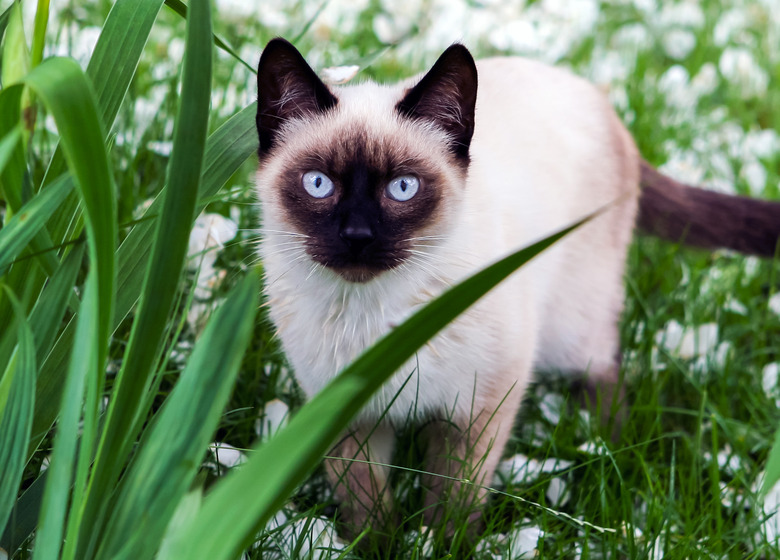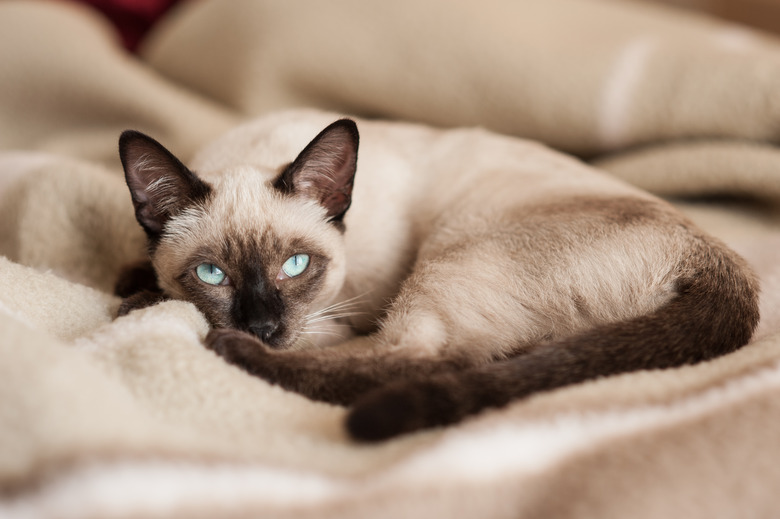Siamese Cat Eye Problems
One of the most striking features of Siamese cats are their piercing blue eyes. The breed is prone to several health issues, including eye conditions such as progressive retinal atrophy, glaucoma, convergent strabismus, and nystagmus. While convergent strabismus and nystagmus are harmless, progressive retinal atrophy and glaucoma can cause a Siamese to lose their vision.
Progressive retinal atrophy
Progressive retinal atrophy
Progressive retinal atrophy is an inherited condition in which a Siamese's eyes are genetically programmed to lose vision over time, according to Prestige Animal Hospital. Most affected cats will begin to show signs between 18 months and two years of age. Cats with progressive retinal atrophy typically develop night blindness first. The condition progresses over a period of two to four years and results in total blindness in most cases. There are no effective treatments or cures for this eye condition.
Progressive retinal atrophy is genetically recessive, meaning that an affected cat has two copies of the gene — one inherited from each of their parents. A cat who only inherits one copy of the gene is a carrier and is not affected by the condition. A genetic test exists that can determine if potential parents are carriers before they are used for breeding.
Feline glaucoma: Increased eye pressure
Feline glaucoma: Increased eye pressure
According to Cornell University College of Veterinary Medicine, feline glaucoma is a condition in which the aqueous humor, the name for the watery part of the eye located just behind the lens, cannot drain properly. When this fluid builds up, it puts pressure on the optic nerve, which connects the eye to the brain. The pressure causes nerve damage, which results in vision loss. Without treatment, glaucoma can lead to partial or total blindness in cats.
Feline glaucoma can be difficult for cat owners to detect as the signs of the condition tend to be subtle. You may notice one or both of your cat's eyes becoming progressively cloudy or larger over time. You may notice that one of your cat's eyes looks larger than the other. Your cat's pupil may appear dilated, and it does not react to light.
Because the condition typically progresses over a period of months, behavioral changes may not be obvious to cat owners. Despite significant eye discomfort, most cats will be able to carry on their daily activities. Unfortunately, there is no cure for glaucoma. However, eye drops can be prescribed to help reduce eye pressure and inflammation, which can ease the discomfort associated with the condition.
Feline convergent strabismus: Crossed eyes
Feline convergent strabismus: Crossed eyes
The medical term for crossed eyes is convergent strabismus. While it may be considered a birth defect in some cat breeds, convergent strabismus is not uncommon in Siamese cats.
Convergent strabismus can occur in cats at any age. When a cat is born cross-eyed, the condition may be reflective of abnormalities in the development of the eye muscles, the eye, or the brain, according to PetPlace. When a cat suddenly develops convergent strabismus as an adult, it could be an indication of a serious eye problem. Take your cat to your veterinarian if you notice any changes in his or her eyes.
Nystagmus in cats: Involuntary eye movement
Nystagmus in cats: Involuntary eye movement
Nystagmus is a congenital eye condition Siamese can be born with. Nystagmus involves a cat's eyes moving from side to side rapidly.
According to AnimalPath, there are two types of nystagmus — jerk nystagmus and pendular nystagmus. In jerk nystagmus, the eye moves slowly from one side to the other in one direction and rapidly from side to side in the other direction. Pendular nystagmus causes the eyes to move from side to side at the same speed.
Address eye changes in cats
Address eye changes in cats
If you notice any changes in your cat's eyes, such as cloudiness, discharge, or weepiness, take him or her to your veterinarian for an examination. Even small changes in the appearance of your cat's eyes can indicate the presence of a serious problem.


